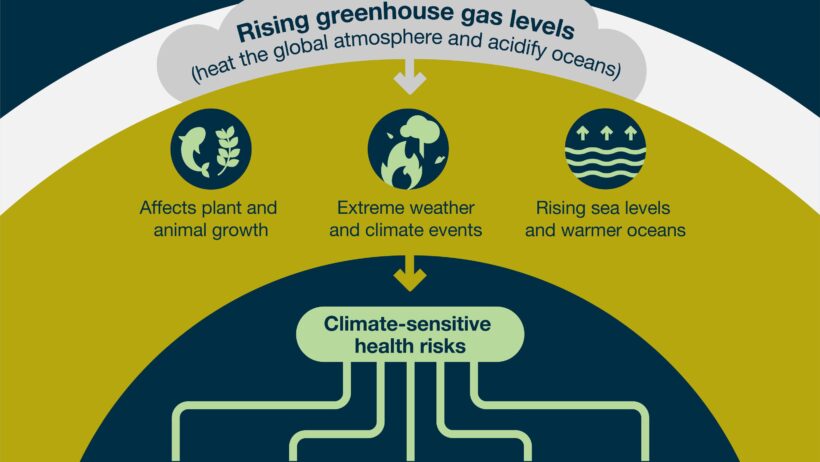Climate change is no longer a distant threat hovering on the horizon; it is a clear and present danger, impacting the very fabric of human existence. As the planet warms, it leads to a myriad of health concerns, much like a fever signaling that the body is out of balance. The human body, already a complex machine, is at risk of overheating, affected by heatwaves, vector-borne diseases, and a cornucopia of respiratory ailments. The time has come to dissect how climate change will affect human health, encompassing an intricate web of consequences—from heatwaves to cardiac risks.
Firstly, let us delve into the insidious nature of heatwaves, akin to a slow cooker simmering away. Prolonged exposure to temperatures that soar above average can lead to heat-related illnesses; conditions such as heat exhaustion and heat stroke are the proverbial canaries in the coal mine, indicating a larger health crisis at hand. Vulnerable populations, including the elderly, children, and those with pre-existing health conditions, bear the brunt of these extreme events. These groups are not merely collateral damage; they represent a significant portion of society. The intensity and frequency of these heatwaves have markedly increased, as the climate continues its worrisome transformation.
Yet, it is imperative to acknowledge that the implications of climate change on health extend far beyond the rising mercury levels. Air quality deteriorates as pollutants become increasingly prevalent in this newly warmed world. Respiratory diseases, especially asthma and chronic obstructive pulmonary disease (COPD), are exacerbated. The relationship between climate change and air quality is like a double-edged sword. The heat serves as a catalyst, promoting the formation of ground-level ozone—an invisible enemy that inflicts damage on our respiratory systems. Asthmatic children, those who dare to breathe deep, find themselves at war against this invisible foe.
Moreover, consider the consequences of shifting weather patterns. The increasing prevalence of torrential rains and flooding produces a breeding ground for waterborne diseases, inviting pathogens that flourish in stagnant waters. When flooding occurs, the doors of opportunity for diseases like cholera and leptospirosis swing wide open. Communities, especially in less developed regions, become sitting ducks, devoid of adequate sanitation infrastructure to combat these health crises. The ramifications are profound; communities face not just the immediate fallout of rising water levels but also the long-term effects on mental well-being as these outbreaks disrupt social cohesion.
The intricate relationship between climate change and infectious diseases cannot be understated. The warming climate fosters a fertile environment for vectors such as mosquitoes and ticks, who spread ailments like malaria, dengue fever, and Lyme disease. Imagine a world where once-rare diseases become commonplace, striking at the heart of those living in vulnerable zones. This is the crisis looming over populations. The shifting geographic ranges of these vectors and the diseases they carry create unpredictable public health challenges. With each degree of temperature rise, entire communities find themselves unprepared for the resurgence of these once-controlled diseases.
Climate change also beckons a host of mental health issues, as individuals and communities grapple with loss, displacement, and anxiety about the future. The metaphorical shoes of “climate anxiety” are ill-fitting for many as they struggle to cope with the uncertainties that climate change engenders. Natural disasters, fueled by climate change, displace populations and instill fear, creating a psychological tapestry woven with threads of PTSD, depression, and other mental health challenges. It is an invisible struggle, yet the weight of this burden is no less real, as communities reel from loss, variability, and uncertainty.
Additionally, the economic implications of climate-related health issues are staggering. A society unwell is a society unproductive. The escalating costs of healthcare stemming from climate-induced illnesses will burden healthcare systems and stifle national economies. The cycle perpetuates; as climate change necessitates increased spending on healthcare, opportunities to invest in climate mitigation wane. Here lies a foundational question: will societies prioritize human health over economic growth? The dichotomy is stark, yet a moment of reckoning must occur.
As we traverse through the ramifications of climate change, it is essential to nurture a sense of agency and resilience. Robust public health systems, renewed focus on sustainable practices, and community engagement can collectively engineer a response to this looming tragedy. Awareness and education about the health risks associated with climate change will empower individuals to take action— be it reducing personal carbon footprints, advocating for policy changes, or supporting mental health initiatives for those suffering from climate grief.
The collective responsibility rests on the shoulders of society, demanding activism, innovation, and compassion. When confronting climate change, we must transcend the traditional paradigms of health and confront this multi-faceted crisis with a holistic approach. Only then can we forge a future where human health and the environment flourish in tandem, creating a symbiotic relationship that honors both the planet and its inhabitants. The unfolding narrative of climate change is not merely a tale of rising temperatures and acclimatization; it is one of survival, resilience, and the quest for equilibrium in a changing world.
In conclusion, the protean nature of climate change evokes a pressing urgency to address its vast implications for human health. The interconnectedness of physical health, mental well-being, and environmental sustainability lays the groundwork for a collective response. The time to act is now, for the health of the planet—and of humanity—hangs in the balance.








